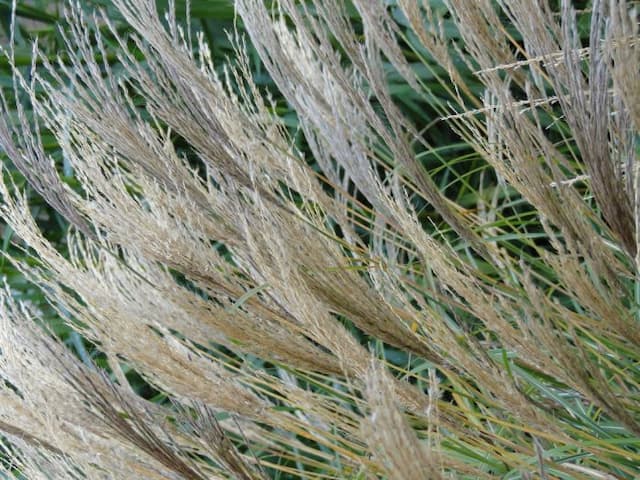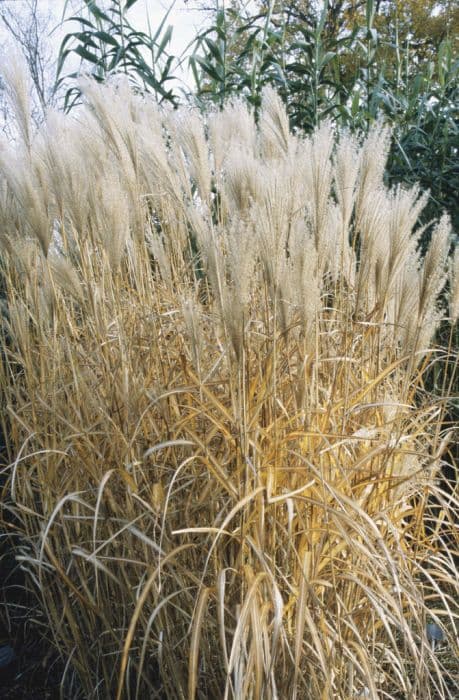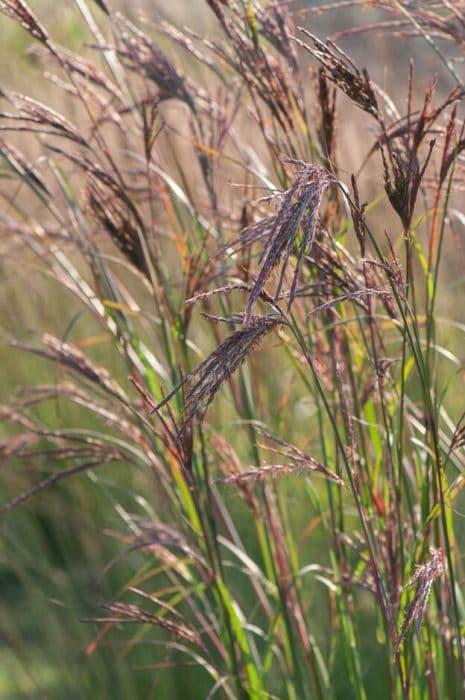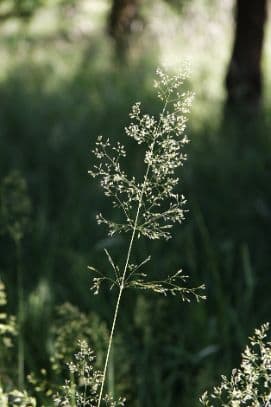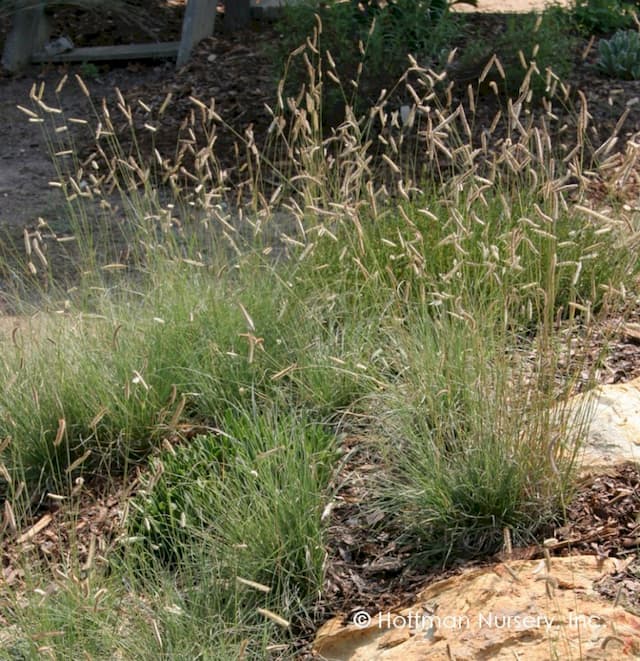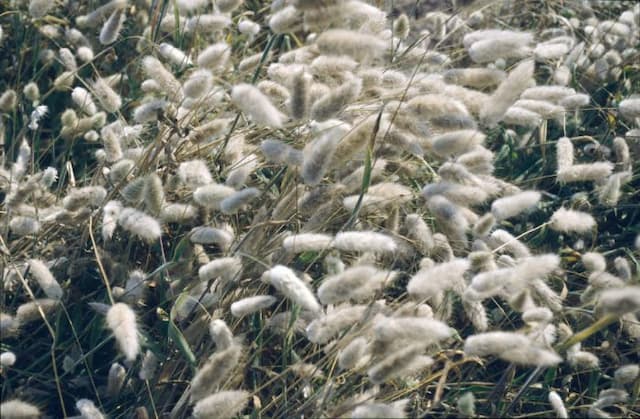Pampas Grass Cortaderia selloana 'Patagonia'

ABOUT
Cortaderia selloana 'Patagonia', commonly known as Pampas Grass, is a visually striking ornamental plant known for its lush, tufted appearance. It features long and arching leaves that form a dense, grass-like clump. The leaves have a narrow, blade-like shape, and display a silvery green color. Its most distinctive characteristic is its feathery plumes or flower spikes, which emerge above the foliage. These plumes are very fluffy and usually appear in a creamy white to soft silvery hue, adding a touch of elegance and a dramatic visual effect. The Pampas Grass has a graceful, flowing form that gently moves with the breeze, which can add both texture and movement to a garden setting. Despite being widely admired for its decorative plumes and foliage, care must be taken with Pampas Grass as the leaves can have sharp edges.
About this plant
 Names
NamesFamily
Poaceae
Synonyms
Pampas Grass, Andean Pampas Grass, Argentine Pampas Grass, White Pampas Grass
Common names
Cortaderia selloana 'Patagonia'.
 Toxicity
ToxicityTo humans
Pampas grass (Cortaderia selloana 'Patagonia') is not commonly known for its toxicity when ingested. There are no widespread reports of poisoning or toxic reactions in humans from consuming this plant. However, its physical attributes, particularly the sharp edges of its leaves, can cause physical irritation or injury to the skin and eyes upon contact.
To pets
Pampas grass (Cortaderia selloana 'Patagonia') is similarly not known to be toxic to pets when ingested. There are no common reports of pets being poisoned from consuming pampas grass. However, like in humans, the physical structure of the plant, which includes sharp leaf blades, can cause cuts or irritation to a pet's skin, mouth, or eyes if they come into contact with or try to eat the grass.
 Characteristics
CharacteristicsLife cycle
Perennials
Foliage type
Evergreen
Color of leaves
Green
Flower color
Varies
Height
6 feet (1.8 meters)
Spread
4 feet (1.2 meters)
Plant type
Grass
Hardiness zones
7
Native area
South America
Benefits
 General Benefits
General Benefits- Ornamental Value: Adds visual interest to gardens with its tall, flowing plumes and grassy foliage.
- Drought Tolerance: Once established, it is highly tolerant of drought, making it suitable for low-water landscapes.
- Low Maintenance: Requires minimal care once established, which can save time and resources for gardeners.
- Wildlife Attraction: The plumes can attract birds that use them for nesting material.
- Windbreak: Its dense growth can serve as a protective barrier against winds when planted in groups.
- Soil Stabilization: The plant's root system helps to prevent soil erosion on slopes and banks.
- Long-Lived: It is a perennial that can live and thrive for many years, providing long-term structure in gardens.
- Seasonal Interest: Offers year-round interest, with greenery in spring and summer and distinctive seed heads in fall and winter.
- Variety in Landscapes: Can be used in various garden styles, including formal, naturalistic, and even coastal settings.
 Medical Properties
Medical PropertiesThis plant is not used for medical purposes.
 Air-purifying Qualities
Air-purifying QualitiesThis plant is not specifically known for air purifying qualities.
 Other Uses
Other Uses- Sound Barrier: Cortaderia selloana, commonly known as pampas grass, can grow quite tall and dense, making it an effective natural sound barrier when planted along highways or between properties.
- Erosion Control: The deep and extensive root system can help stabilize hillsides and slopes, preventing soil erosion especially in sandy or unstable soils.
- Living Fences: Pampas grass can be used to create living fences or hedges to demarcate boundaries and provide privacy due to its dense growth.
- Themed Gardens: It can be a key element in a South American or prairie-themed garden, giving landscapes an instant naturalized look.
- Biodegradable Crafting Material: Dried pampas grass plumes can be used for making biodegradable crafts, wreaths, and floral arrangements.
- Seasonal Displays: The plumes are often sprayed with festive colors and used for special occasions like Halloween or Christmas to create a seasonal aesthetic.
- Backdrop for Photography: With its tall and fluffy plumes, pampas grass serves as a popular backdrop for outdoor photography and weddings.
- Wildlife Shelter: The dense foliage provides shelter and habitat for various species of birds, insects, and small mammals.
- Feng Shui: Some practitioners use pampas grass in the home or garden to adhere to Feng Shui principles, promoting a sense of balance and positive energy flow.
- Privacy Screens for Spa Areas: By planting them around outdoor spa or pool areas, one can create a cozy, private retreat shielded from onlookers.
Interesting Facts
 Feng Shui
Feng ShuiThe Pampas Grass is not used in Feng Shui practice.
 Zodiac Sign Compitability
Zodiac Sign CompitabilityThe Pampas Grass is not used in astrology practice.
 Plant Symbolism
Plant Symbolism- Beauty and Grace: The Cortaderia selloana, commonly known as Pampas Grass, with its tall, feathery plumes, is often associated with beauty and grace due to its elegant and aesthetic appearance that can add a touch of sophistication to any landscape or floral arrangement.
- Wealth and Abundance: The lush and full growth pattern of Pampas Grass symbolizes wealth and abundance, suggesting a plentiful and prosperous life.
- Protection: Native cultures may have used Pampas Grass as a form of protection; the tough, sharp leaves can create a barrier, at times representing safety and security.
- Fertility and Virility: Its ability to thrive and propagate easily makes Pampas Grass a symbol of fertility and virility, reflecting the plant's capacity to produce seeds abundantly, thus ensuring the continuation of life.
- Freedom and Ease: The way Pampas Grass sways effortlessly in the wind may symbolize a sense of freedom and ease, where it moves gracefully and adapts to the changing environment.
 Water
WaterPampas Grass, commonly known as Cortaderia selloana 'Patagonia', prefers deep, infrequent watering to encourage strong root development. It should be watered once a week, providing about 1 inch of water each time. During hot, dry spells, you may need to water twice a week. The soil should be allowed to dry out slightly between waterings. For mature plants, a total of approximately 1 to 1.5 gallons per week should suffice. Young plants or newly planted specimens may require slightly more frequent watering until established.
 Light
LightPampas Grass thrives in full sunlight, requiring at least six hours of direct sun per day to grow healthy and produce its signature plumes. The best spot for planting Pampas Grass is an open area where it won't be shaded by buildings or other plants. It can tolerate partial shade but won't flower as prolifically.
 Temperature
TemperaturePampas Grass is hardy and can tolerate a wide range of temperatures. It can survive in conditions as cold as 20 degrees Fahrenheit and as high as 100 degrees Fahrenheit. The ideal temperature range for Pampas Grass is between 70 and 90 degrees Fahrenheit, which promotes optimal growth and plume production.
 Pruning
PruningPampas Grass benefits from annual pruning to remove old foliage and make room for new growth. The best time to prune Pampas Grass is late winter or early spring before new shoots appear. Using sharp shears or a saw, cut the grass down to about 1 to 2 feet above the ground. Prune once a year to maintain plant size and health, and to encourage the production of fresh, vibrant plumes.
 Cleaning
CleaningAs needed
 Soil
SoilPampas Grass prefers a well-draining soil mix with a pH range of 6.1 to 7.5. A blend of garden soil, peat or compost, and sand or perlite can create favourable conditions for its growth.
 Repotting
RepottingPampas Grass doesn't typically require frequent repotting as it is often planted directly in the ground. If grown in containers, repotting every 2 to 3 years is sufficient to provide fresh soil and room for growth.
 Humidity & Misting
Humidity & MistingPampas Grass is tolerant of a wide range of humidity levels and does not have specific humidity requirements. It is adaptable to both dry and humid climates outdoors.
 Suitable locations
Suitable locationsIndoor
Provide full sun and good air circulation for Pampas Grass.
Outdoor
Plant Pampas Grass in full sun with well-draining soil.
Hardiness zone
7-11 USDA
 Life cycle
Life cyclePampas grass (Cortaderia selloana 'Patagonia') begins its life cycle with seed germination, which requires light and can occur on a wide range of soil types, though it prefers well-drained, fertile soil. After germination, seedlings establish themselves and start to develop long, narrow leaves, forming a dense tussock. As the plant matures, it enters a vigorous vegetative growth stage where it continues to expand in size, with leaves potentially reaching several meters in length. In summer to fall, mature pampas grass produces tall, feathery flower plumes that can rise several feet above the foliage, with some being silver or pink depending on the sex of the plant, as pampas grass is dioecious with male and female flowers on separate plants. Following the flowering stage, seeds are produced and dispersed by wind, allowing the cycle to continue. Pampas grass is a perennial plant and can live for several years, during which the plant can go through multiple flowering and seeding cycles before eventually dying.
 Propogation
PropogationPropogation time
Spring to summer
The most popular method of propagation for the Pampas Grass, specifically the Cortaderia selloana 'Patagonia', is division. This process is typically done in late winter or early spring just before the plant resumes active growth. The first step is to dig up the mature clump, ensuring to get as much of the root system as possible. It’s best to use a spade or garden fork to divide the root mass into sections, each with several healthy shoots and a portion of the root system. Plant the divisions promptly at the same soil depth they were growing previously, spacing them about 6 feet (approximately 1.8 meters) apart to accommodate their full size. Water the new divisions thoroughly to help establish them. This method is favored because it preserves the characteristics of the parent plant and allows for rapid establishment of new Pampas Grass plants.

